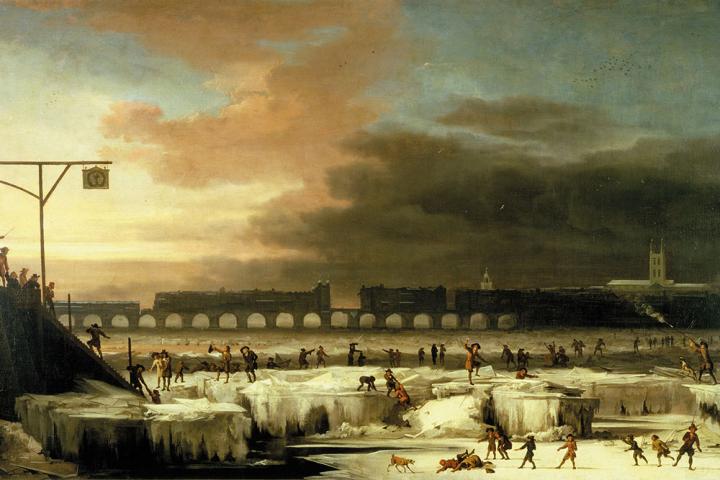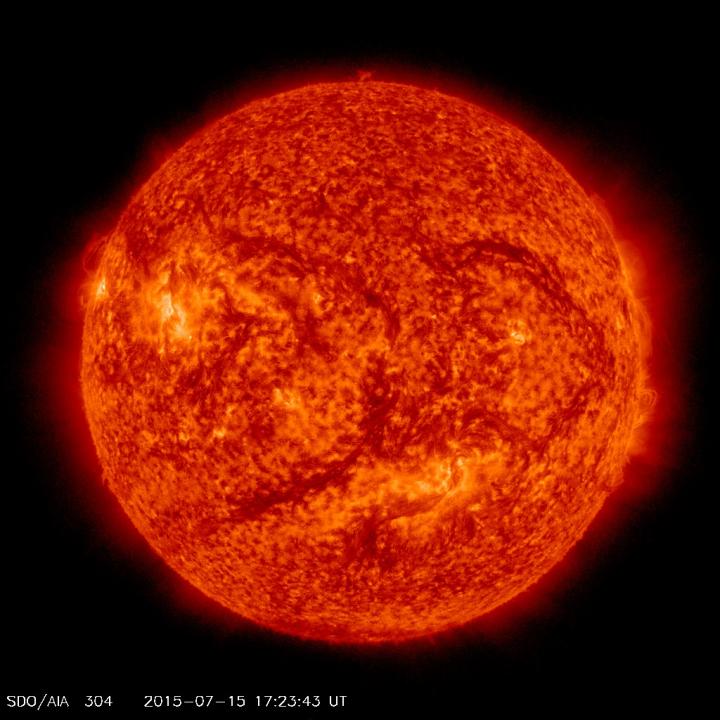The arrival of intense cold similar to what some call the "Little Ice Age" of the late 17th century and early 18th century, is expected in the years 2030 to 2040, according to a presentation during the National Astronomy Meeting in Wales.
Why so?
The Sun has its own magnetic field and its amplitude and spatial configuration vary with time. The formation and decay of strong magnetic fields in the solar atmosphere results in the changes of electromagnetic radiation from the Sun, of the intensity of plasma flows coming from the Sun, and the number of sunspots on the Sun's surface. It is cyclic, in one case changing around every 11 years, and we have been able to detect these changes in the past using analysis of carbon-14, beryllium-10 and other isotopes in glaciers and trees.
But there is also a 90-year cycle, which has gotten far less attention.
The 11-year cycle appears as a cyclical reduction in stains on the surface of the Sun while the 90-year variation reduces the number of spots in the 11-year cycle another 25 to 50 percent. In the 17th century there was a prolonged of solar activity called the Maunder minimum, which lasted roughly from 1645 to 1700. During this period, there were only about 50 sunspots instead of the usual 40-50,000 sunspots. Analysis of solar radiation showed that its maxima and minima almost coincided with the maxima and minima in the number of spots.
The result was exceptional cold. And it is about to happen again, according to an analysis of background magnetic field from full disk magnetograms for three cycles of solar activity using principal component analysis.

"The Frozen Thames, looking Eastwards towards Old London Bridge" by Abraham Hondius, 1677.
Credit: Museum of London
A change in the total quantity of electromagnetic radiation by only 1% can result in a noticeable change in the temperature distribution and air flow all over the Earth. Ultraviolet rays cause a photochemical effect, which leads to the formation of ozone at the altitude of 30-40 km. The flow of ultraviolet rays increases sharply during chromospheric flares in the Sun. Ozone, which absorbs the sun's rays well enough, is being heated and it affects the air currents in the lower layers of the atmosphere and, consequently, the weather. Powerful emission of corpuscles, which can reach the Earth's surface, arise periodically during the high solar activity. They can move in complex trajectories, causing aurorae, geomagnetic storms and disturbances of radio communication.
By increasing the flow of particles in the lower atmospheric layers air flows of meridional direction enhance: warm currents from the south with even greater energy rush in the high latitudes and cold currents, carrying arctic air, penetrate deeper into the south. In addition, the solar activity affects the intensity of fluxes of galactic cosmic rays. The minimum activity streams become more intense, which also affects the chemical processes in the Earth's atmosphere
The study of deuterium in the Antarctic showed that there were five global warmings and four Ice Ages for the past 400,000 years. The increase in the volcanic activity comes after the Ice Age and it leads to the greenhouse gas emissions. The magnetic field of the Sun grows, what means that the flux of cosmic rays decreases, increasing the number of clouds and leading to the warming again. Next comes the reverse process, where the magnetic field of the Sun decreases, the intensity of cosmic ray rises, reducing the clouds and making the atmosphere cool again. This process comes with some delay.
By using their own data dimensionality to identify waves with the largest contribution to the observational data - they liked it to comparing the decomposition of white light on the rainbow prism to waves of different frequencies - they have determined that the magnetic waves in the Sun are generated in pairs, with the main pair covering 40% of variance of the data (Zharkova et al, 2012, MNRAS). The principal component pair is responsible for the variations of a dipole field of the Sun, which is changing its polarity from pole to pole during 11 year solar activity.
The magnetic waves travel from the opposite hemisphere to the Northern hemisphere (odd cycles) or to Southern hemisphere (even cycles), with the phase shift between the waves increasing with a cycle number. The waves interacts with each other in the hemisphere where they have maximum (Northern for odd cycles and Southern for even ones). These two components are assumed to originate in two different layers in the solar interior (inner and outer) with close, but not equal, frequencies and a variable phase shift (Popova et al, 2013, AnnGeo).

Image of the sun was taken by NASA Solar Dynamics Observations mission on July 15, 2015, at a wavelength of 304 Angstroms. Credit: NASA Solar Dynamics Observations
They created an analytical formula to describe the evolution of these two waves and calculated the summary curve which was linked to the variations of sunspot numbers, the original proxy of solar activity, if one used the modulus of the summary curve (Shepherd et al, 2014, ApJ). By using this formula the scientists made first the prediction of magnetic activity in the cycle 24, which gave 97% accuracy in comparison with the principal components derived from the observations.
They extended the prediction of these two magnetic waves to the next two cycle 25 and 26 and discovered that the waves become fully separated into the opposite hemispheres in cycle 26 and thus have little chance of interacting and producing sunspot numbers. This will lead to a sharp decline in solar activity in years 2030-2040, comparable with the conditions existed previously during the Maunder minimum in the XVII century when there were only about 50-70 sunspots observed instead of the usual 40-50 thousand expected.
Their conclusion: Global cooling is coming.
The new reduction of the solar activity will lead to reduction of the solar irradiance by 3W/m^2 according to Lean (1997). This resulted in significant cooling of Earth and very severe winters and cold summers.
"Several studies have shown that the Maunder Minimum coincided with the coldest phase of global cooling, which was called "the Little Ice Age". During this period there were very cold winters in Europe and North America. In the days of the Maunder minimum the water in the river Thames and the Danube River froze, the Moscow River was covered by ice every six months, snow lay on some plains year round and Greenland was covered by glaciers," says Dr Helen Popova, who developed a physical-mathematical model of the evolution of the magnetic activity of the sun and used it to gain the patterns of occurrence of global minima of solar activity and gave them a physical interpretation.

Dr. Helen Popova of the Skobeltsyn Institute of Nuclear Physics and of the Faculty of Physics of the Lomonosov Moscow State University.
Credit Lomonosov Moscow State University
If the similar reduction will be observed during the upcoming Maunder minimum this can lead to the similar cooling of the Earth atmosphere. According to Popova, if the existing theories about the impact of solar activity on the climate are true, then this minimum will lead to a significant cooling, similar to the one occurred during the Maunder minimum.
Math is great but academics are not really considered the gold standard when it comes to creating numerical models, much less climate ones. So don't invest in Big Parka just yet.
"Given that our future minimum will last for at least three solar cycles, which is about 30 years, it is possible, that the lowering of the temperature will not be as deep as during the Maunder minimum. But we will have to examine it in detail. We keep in touch with climatologists from different countries. We plan to work in this direction," Popova said.
That means human impact on climate will be less than projected, she says. "There is no strong evidence that global warming is caused by human activity. The study of deuterium in the Antarctic showed that there were five global warmings and four Ice Ages for the past 400 thousand years. People first appeared on the Earth about 60,000 years ago. However, even if human activities influence the climate, we can say, that the Sun with the new minimum gives humanity more time or a second chance to reduce their industrial emissions and to prepare, when the Sun will return to normal activity."





Comments